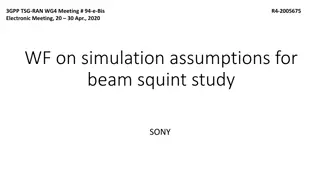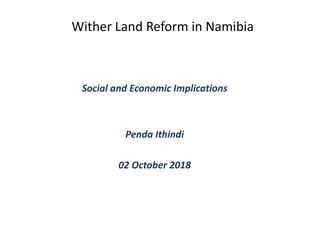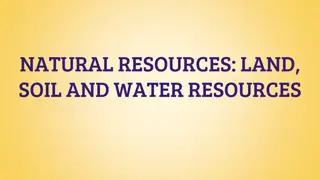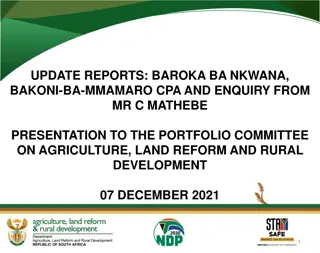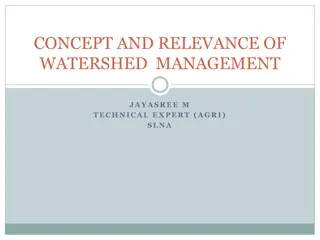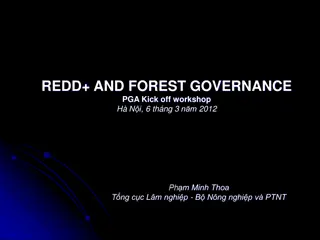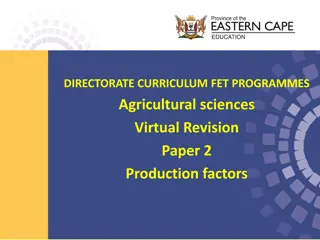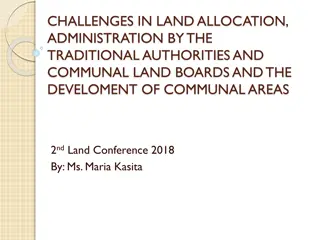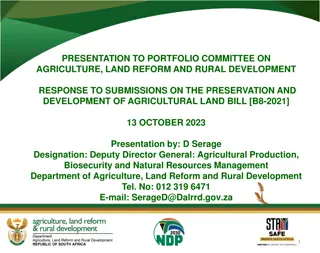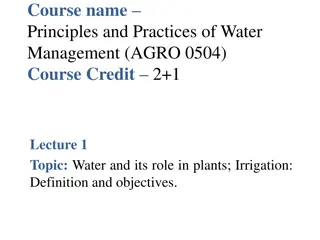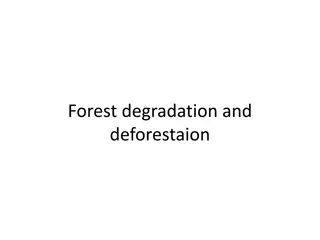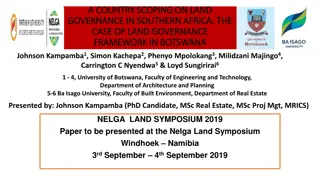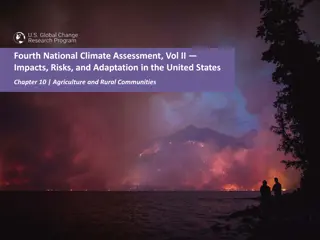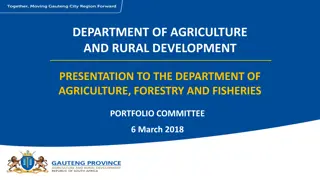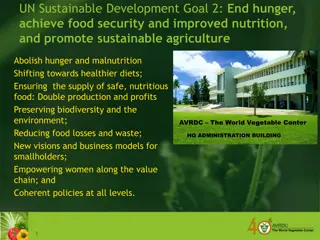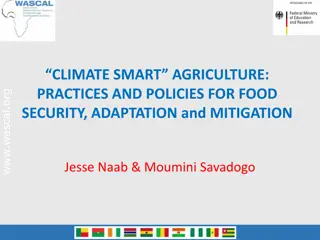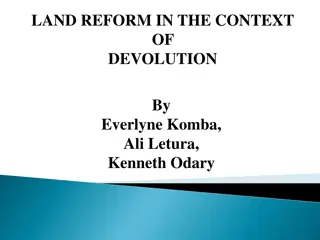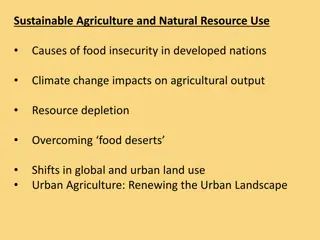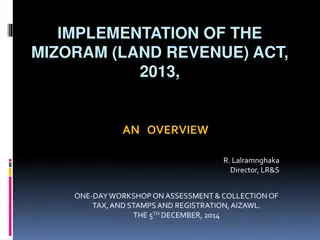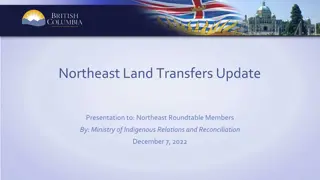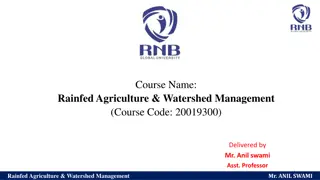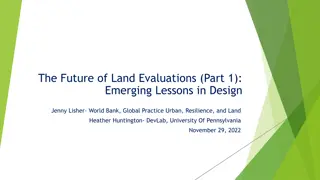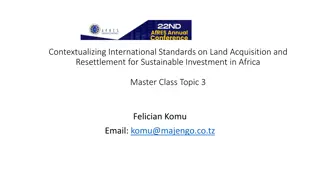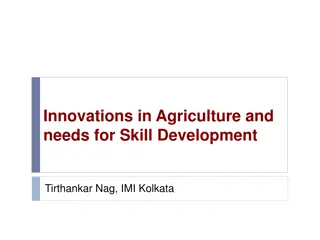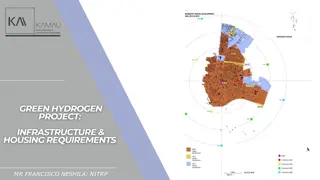Addressing Land Degradation Challenges in Agriculture for Sustainable Development
World agriculture has evolved over the decades, facing challenges like environmental degradation and land misuse. Awareness-raising activities on biosafety and biodiversity are crucial for informed decision-making in agriculture. Nigeria, with its diverse ecological zones, must sustainably manage natural resources to support its increasing population. The presentation by Mohammed Sabo Nanono highlights the need for policies that promote sustainable agriculture to address issues like deforestation, desertification, erosion, and land degradation. Implementing solutions will contribute to food security, economic development, and biodiversity conservation.
Download Presentation

Please find below an Image/Link to download the presentation.
The content on the website is provided AS IS for your information and personal use only. It may not be sold, licensed, or shared on other websites without obtaining consent from the author. Download presentation by click this link. If you encounter any issues during the download, it is possible that the publisher has removed the file from their server.
E N D
Presentation Transcript
FACILITATING AWARENESS RAISING ACTIVITIES ON BIOSAFETY AND BIODIVERSITY ISSUES FOR GOVERNMENT AND OTHER STAKE HOLDERS FOR INFORMED DECISIONS AND POLICIES ON NATURE AND MAN BY MOHAMMED SABO NANONO HON. MINISTER OF AGRICULTURE AND RURAL DEVELOPMENT PRESENTATION AT WEBINER BY THE EVERY WOMAN HOPE CENTRE(EWHC) 8TH DECEMBER, 2020 NON
Introduction Over the past six decades world agriculture has become considerably more efficient. Improvements in production systems and crop and livestock breeding programmes have resulted in doubling of food production while increasing the amount of agricultural land by 10 percent. Estimates show that world population will grow from the current 6.7 billion by 2050 with most of the increase occurring in South Asia and Sub-Saharan Africa. Taking into account the changes in the composition and level of consumption associated with growing household incomes, FAO estimates that feeding the world population will require a 70 percent increase in total agricultural production (Bruinsma, 2009). Nigeria s land mass covers approximately 923,800 sq km with over seven distinct ecological zones endowed with diverse natural resources which play a vital role in socio - economic development of the nation. Together, these constitute the country s main natural capital base. It is from these assets that the provision of food, water, wood, fiber and industrial products, and essential ecosystem services and functions are derived. Yet, these must be sustainably maintained in order to support the nation s increasing population now and in the future. Agriculture (including forestry, fisheries and livestock) employs about 70% of the labour force, and accounts for about 24% GDP according to the National Bureau of Statistics and is also responsible for the food security of the Country.
Introduction Contd However, the prevalent challenges of environmental degradation have resulted in losses that threaten the productivity and sustainability of the nation s land and water resources. For instance, Nigeria has the highest deforestation rate of primary forest in Africa, with annual losses estimated at 11.1 percent between 2000 to 2008 (FAO, 2005): Desertification in the northern fringes is said to be advancing at the rate of 0.6 km per annum with as much as 351,000sq km threatened by desert (FME, 2006). Erosion poses a significant threat to land development.
Introduction Contd Causes of land degradation include inappropriate agricultural practices and misuse of agricultural lands, including the improper use of renewable natural resources, urbanization and infrastructural expansion, commercial logging, high demand for wood and fuel wood, overgrazing, population pressure on resources, weak institutions and policies, poverty, land tenure, soil infertility and nutrient mining, etc. (World Bank, 2005). Land use change accounts for about 65% of Africa s greenhouse gas emission with links to the continent s land degradation and Biodiversity loss. Land degradation problems are intertwined with the risk and vulnerability associated with Climate change affecting all sectors and socio-economic development, leading to among others: Loss of biodiversity, Rapid deterioration in land cover, Depletion of water availability through destruction of catchment and aquifers; Forest regeneration becoming more difficult; Low productivity and postharvest losses; Soil depletion and nutrient mining Low soil quality and health (acidification and salinization) Conflicts in natural resource use and migration
Biodiversity Biodiversity is the variability among living organisms from all sources, including terrestrial, marine and other aquatic ecosystems and the ecological complexes of which they are part; this includes diversity within species between species and ecosystem. Biodiversity forms the foundation of the vast array of ecosystem services that critically contribute to human well-being. Climate-smart agriculture (CSA) has been identified to address most of the identified land degradation problems including loss of biodiversity , this approach involves multiple transformative transitions and a complex set of objectives for which there are newly identified knowledge gaps and a need to build evidence and design trajectories. CSA requires bringing together the climate change impact community and the agricultural research community as well as bridging across the diversity of disciplines in agricultural sciences and environment. It integrates the three dimensions of sustainable development (economic, social and environmental) by jointly addressing food security and climate challenges. It is composed of three main pillars: sustainably increasing agricultural productivity and incomes; adapting and building resilience to climate change; and reducing and/or removing greenhouse gas emissions, where possible. I. II. III.
Nigeria recognises the acute and unexpected threats climate change poses to its development, hence, significant progress has been made by the Federal Government of Nigeria (FGN) and some States in the formulation of strategies, policies and plans to incentivize a shift to CSA in Nigeria. National Adaptation Strategy and Plan of Action for Climate Change Nigeria (NASPA-CCN, 2011) Nigeria Climate Change Policy Response Strategy (2012) The National Agricultural Resilience Framework (NARF 2014) Nationally Determined Contributions (NDCs, 2015) Nigeria Communication on Climate Smart Agriculture (2015) Climate Smart Agriculture Profile- CSA profiling for 3 Northern States Agriculture Promotion Policy (2016 2020) launched in August 2016 by National Biodiversity strategy and action plan
Strategic and action plan for biodiversity Inclusion of the subjects and texts on biodiversity conservation into the national primary and secondary education and the General Studies (GS) of tertiary institution curricula Host an annual National Biodiversity dialogue, and Press Conference Promote environmental social media networking among the Nigerian youth Develop and produce agro climatic atlas for climate scenaros and modeling Capacity building on innovative SLM best practices for extension staff, Ecourage research and development on SLM including local and indigenous knowledge and validation of best practices Support deregulation and mainstream of SLWM policies to state level actors, to upscale and implement best practices; Conduct outreach and awareness campaigns (radio, jingles etc), information sharing and public discussions on Nigeria s biodiversity and its significance to ecology, economy, life and services, with specific emphasis on indigenous and local communities Establish and implement a national procedure for Payment for Ecosystem Services (PES), to enhance private sector investment and corporate social support to Nigeria s biodiversity protection. Strengthen and implement the provisions of Environmental Impact Assessments (EIA). Conduct a National Biodiversity survey, to identify habitats of high biodiversity and ecosystem services value and priorities for ecosystem restoration and new conservation areas.
Safeguarding of wildlife corridors as part of spatial development/habitat connectivity axes/Green Infrastructure. Review and strengthen the National Forest Policy, to improve production efficiency whilst promoting conservation of high- biodiversity habitats and restoration of degraded areas Develop a national strategy for the conservation of agricultural biodiversity and promotion of agro-forestry. Promote alternative livelihoods for communities in protected areas and ecosystem restoration areas. Establishment of Nigerian National gene bank for cultivated plants and domesticated animals Strengthen the capacity of the Plant Quarantine Services Department for effective border control Survey the flora and fauna outside protected areas, including sacred groves, community lands, abandoned farmlands and homesteads, and assist local communities in the sustainable management of these sites. Strategic and action plan for biodiversity
Programmes and Projects to address Biodiversity loss It is also of interest to note that between 2014 2020, the FMARD has made significant strides at both global and domestic scene towards implementing a number of programmes and projects on climate smart agriculture to mitigate the impact of climate change in Nigeria. They include; Establishment of Automatic Weather Stations, Construction and Rehabilitation of On farm Run-off Water Harvesting Structures Establishment of Pilot Demonstration Farms on Agroforestry (AF), Farmer Managed Natural Regeneration (FMNR), Conservation Agriculture (CA) Climate Change Adaptation and Agric. Business Support Programme in the Seven States of Savanna Belt (IFAD Donor Assisted) FADAMA 3 Additional Financing Integrated Landscape Management for Enhanced Food Security and Ecosystem Services in Nigeria (GEF Supported)
Programmes And Projects CONDTD Other CSA related programme intervension are domiciled in the crops, livestock, Fisheries and Aquaculture, etc subsectors of the ministry. CSA Related NEWMAP Activities. Collaborating with Environment on Capacity Development on relevant areas of GHG Emission ( Reporting, Calculation, funding etc.) FMARD is also working with NEPAD Coordinating Agency through TeerAfrica on the Review/Update of Nigeria Country Investment Framework (CSIF SLM), Cross River pilot Review of National Agricultural Resilience Framework (2014) document.
Conclusion Climate change and loss of biodiversity is likely to have a greater effect on food supply than any other factor. Although, substantial progress has been made in developing CSA transformative policies and adaptive farming systems, and agro-ecological technologies that are site specific the applications are often small in scope. The responsibility of government is to create the enabling environment needed to promote action, and that action will be required from a range of sectors like the Federal Ministry of Agriculture and Rural Development (FMARD), Environment, Water Resources, Universities, research institutes including the private sector. What is required now is for us to collectively take positive response actions in the implementation of CSA (adaptation/mitigation) strategies to reduce biodiversity loss.





